Types of Road Trailers
used for cargo transports
A 'trailer' is an unpowered vehicle that is towed by ( trails behind ) a powered vehicle such as a truck. There are different types of (cargo) trailers, each used for a specific purpose or having particular advantages.
Below are the most commonly used cargo-trailer types:
Important:
The photos and information provided via 'external links' are here for your guidance only. We do not own those photos, and we cannot assume any responsibilty for any of the content and/or material in such external links. By clicking any of the links the visitor assumes responsibility. You may, otherwise, use internet search engines with key words provided herein. Thank you.
trailer types
|
characteristics
Box trailer
|
The aluminium box trailer, with its rigid sides and roof, offers the safest conveyance to the cargo. This kind of trailer is sometimes internally equipped with rails to carry 'hanging garments'.
The downside is that it can only be stowed from the rear end, through its 2 solid doors, making it difficult to reach cargo that is loaded deeper inside (if this is to be inspected or unloaded first) and also
difficult to load cargo which is bulky (and long), making it impossible to be loaded by a forklift truck via the cargo's narrow side. The tilt/tarpaulin and curtain-sided trailers (see below) is ideal for such uses.
Tilt trailer
|
The word 'tilt' may be misleading here because of its everyday meaning (vb. to lean). In cargo-related terms, 'tilt' has a different, lesser known meaning: "a cover of coarse cloth, canvas, tarpaulin, etc., as for a wagon". So a 'Tilt Trailer' is one whose sides and roof are not constructed of rigid material, but of this thick, waterproof canvas-like material known as a tarpaulin.
The tilt, better known as the canvas trailer (telato in Italian) is light and versatile as it affords loading from the sides as well as overhead. The downside here is that to open the heavy canvas sides is quite a task, as may be seen in the photos below.
On the inside, there are upright beams supporting the roof and making the entire trailer frame stronger. Between these beams are horizontal planks (usually of wood) designed to keep the cargo from resting on the tarpaulin (canvas) sides. These are removable to allow easy un/loading.
| | |
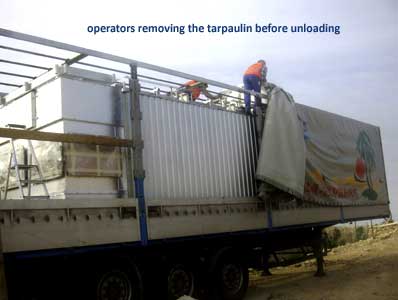
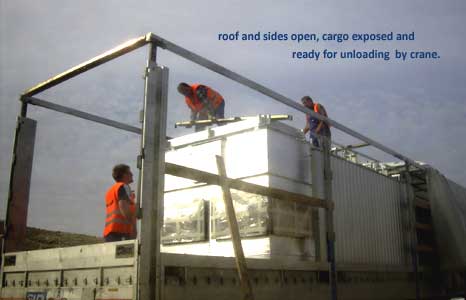
continue "trailer types" below
Curtain-sided
|
These trailers are also suitable for side-loading; even more so because the 'curtain' is easier to open (slide) than the heavy tarpaulin of the tilt trailer (see above) that has to be lifted. This is amongst the most popular of trailer types. Large dimension goods may need to be loaded in this kind of trailer as it is often impossible to load in box trailers (see above).
Curtain-sided trailers may have a rigid roof, but the more useful types have a tarpaulin (canvas) roof that fan-folds normally towards the front (i.e. away from the back door). It is normal for curtain trailers to have rigid doors, similar to box trailers.
|
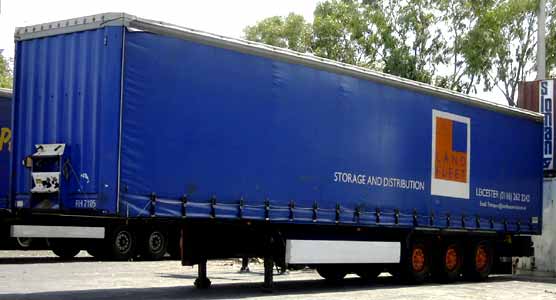
|
Flats
|
Flat-bed trailers are used to carry cargo that can withdtand weather, or cargo that is out-of-gauge. In international transports, this trailer presents a problem in that it cannot be sealed-closed, as with the box, tilt, curtain and reefer types. Flat-bed trailers, also know as Open Trailers have been used to carry sea-containers, especially before the 'skeletal' (or chassis) trailers came into common use.
Low-bed
|
These trailers are also 'open' and are designed for cargo that is 'high' and, therefore, presenting a possible danger in transporting owing to its high centre-of-gravity, whereas on a low-bed trailer ( or 'low-loader') it may be carried more safely.
A variant of these low-bed trailer are 'heavy lift' trailers, which are specially designed and tested to lift much higher tonnage. Whereas road regulations often allow a maximum payload not exceeding 24 tons, the multiple wheel axels of this special equipment could allow loads up to 100 tons, or even 200 tons. Such trailers are very uncommon and owned only by 'heavy load' (or 'heavy lift') specialists. Such transports are commonly known as Project Cargo.
|
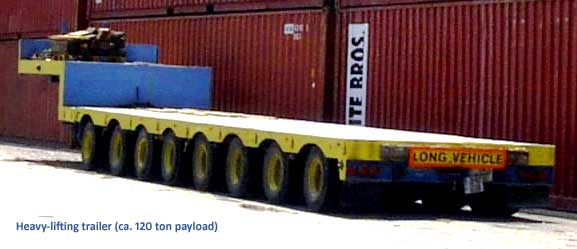
|
Temperature–
controlled
|
Often referred to as "Reefer" or "Refrigerated" units, these trailers are actually insulated box trailers (see above) that are specially fitted with a motor (usually diesel powered) that serves to "maintain" specific, pre-agreed temperatures — generally frozen, chilled, or fresh, but in colder climates this could mean maintaining a temperature that's warmer than the outside, or ambient-, temperature.
Interestingly, the term Refrigerated (or Reefer) is used for convenience, but is actually a misnomer because this kind of equipment should NOT be used to lower cargo temperature, but to maintain it at a 'temperature range', e.g. between 5°C and 10°C. Temperature-controlled trailers often operate in temperatures between 25-negative (minus 25 degrees Celcius) and 25-positive (plus 25 degrees Celcius).
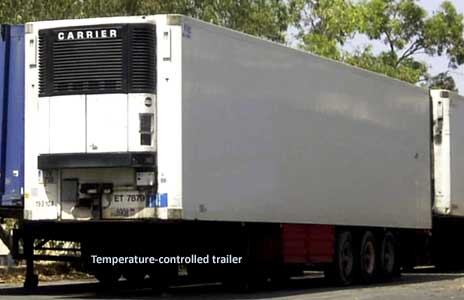
Road Tankers
|
Tank trailers (also known as 'bowsers' in some countries) are designed to carry liquids in bulk. These are used to carry anything from (harmless) water to flammable fuels.
Some tanks are internally divided (partitioned) into smaller compartments so as to break the momentum created by the weight and movement of the liquid, known as a 'surge' that makes the driving of tank trailers the most difficult, if not even dangerous.
external link: http://www.truckingtruth.com/cdl-training-program/page61
Other Types &
Names
|
Euroliners
Curtain-sided, with Mega dimensions, sometimes even bigger.
Tautliners ™
A registered trade name by Utitilty Trailer Manufacturing for their curtain-sided, aluminum roofed trailers.
Dry Bulk
Specialised equipment allowing filling and discharging of material such as grain, flour, chemicals, cement, etc, warranting special trailer design.
These include Hopper-bottom trailers used for carrying grain, specially designed for top loading and bottom discharge. A hopper is a funnel-shaped design.
Road Trains
This is a 'system' of road haulage used only in countries where very long distances are involved, particularly where the terrain is not served by railroad; the Australian outback being the world leader. Examples of such conveyances include the carriage of mineral-ores, fuels and even livestock.
A road train consists of a (powerful engined) 'prime mover' towing two or more trailers in the same way that an train engine pulls train wagons on rails.
Examples of all the above-mentioned trailers may be seen
in these 'external links' (in separate windows):
Important:
The photos and information provided via external links are here for your guidance only. We do not own the photos, and we cannot assume any responsibilty for any of the content and/or material in such external links. By clicking any of the links the visitor assumes responsibility. You may, otherwise, use internet search engines with key words provided herein. Thank you.
dry bulk carriers source: Tremcar, Canada
hopper-bottom trailer source: Sparta Engineering, USA
hopper-trailer design source: Sparta Engineering, USA
hopper-bottom (uncovered) overhead source: Sparta Engineering, USA
short road-train source: Wikipedia website
4-trailer road-train source: Prime Mover magazine, Australia
3-trailer road-train source: Prime Mover magazine, Australia
various trailer types source: P&O Ferrymasters, N.Ireland
|
|
| |
| | | | | |
handy tools at your fingertips
Trailers Dimensions
Unlike sea-containers, that have standard dimensions, trailer sizes may vary between different manufacturers and trailer types.
Please remember that maximum carrying capacity (payload) in terms of weight will depend on local laws regulating the country of operation, as well as those countries through which a trailer would be trasiting.
Below, therefore, are approximate specifications for your guidance:
|
trailer type
|
specifications
|
value
|
Standard Trailer
|
equip. tare wt.
|
8,600 kg
|
standard max cargo wt.
|
24,000 kg
|
internal space (capacity)
|
88 - 90 cubic metres
|
internal length
|
13.60 metres
|
internal width
|
2.40 metres
|
internal height
|
2.70 metres
Overall height from the ground is usually around 4 metres.
For heavy loads, a tri-axle trailer is more suitable
|
Supercubed Trailer
|
internal space (capacity)
|
95 cubic metres
|
Supercubed / Jumbo trailers would normally have 3 sets of smaller wheels coupled with a 'step frame'
in the front (where it overlays the tractor) therefore allowing for a lower floor in the rest of the
deck, so would be higher, resulting in the larger carrying volume.
|
Mega Trailer
|
internal space (capacity)
|
100 cubic metres
|
internal length
|
13.60 metres
|
internal width
|
2.40 metres
|
internal height
|
2.90 metres
|
Mega trailers will have 3 axels at the back and can carry higher pieces that might not fit in standard trailers.
|
Reefer Trailer
|
equip. tare wt.
|
9,000 kg
|
standard max cargo wt.
|
24,000 kg
|
internal space (capacity)
|
85 cubic metres
|
internal length
|
13.30 metres
|
internal width
|
2.40 metres
|
internal height
|
2.60 metres
Frozen goods are heavier, so that Reefer Trailers are practically always tri-axle.
Owing to the trailer walls and roof being insulated, the internal dimensions amy be smaller than a standard unit.
| | | | | | | | | | | | | | | | | | | | | |
Important: The information provided herein is for your guidance only and we strongly urge you to take professional advice in cases of litigation or wherever warrnated, to consult the official publications, as well as to double-check certain specifications, e.g. Container Dimensions with carriers, before committing yourself.
While every effort has been made to ensure that the information provided herein is correct, both the company and the authors repudiate any responsibility in relation to any consequences arising from the application of this data. Please be guided accordingly.

SUMMIT Freight Services Ltd — +356 2558 0461
|
|
|
|
|
|
|
|
|
|
|
|



